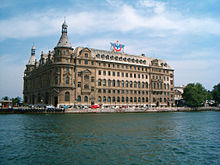Istanbul's local transportation system is a complex network of trams, funiculars, light-rail lines, metro lines, buses, bus rapid transit, and even ferries. Fares across modes are integrated, using the contactless Istanbulkart, introduced in 2009, or the older Akbil electronic ticket device.[224]
Trams date back to 1872, when they were horse-drawn, but Istanbul's original trams were decommissioned in the 1960s. Istanbul experimented withtrolleybuses afterward, but they were also taken out of service, in 1984.[225] Operated by Istanbul Electricity, Tramway, and Tunnel (IETT), trams slowly returned to the city beginning in 1990, with the reopening of the route along İstiklal Avenue.[225] Faster, more modern trams (the T1) were first put into service in 1992, and service across the Golden Horn was restored for the first time in 44 years in 2005. Today, Istanbul's modern tram line, which goes between Kabataş and Bağcılar, has a daily ridership of 265,000 people.[226]
The Tünel (F2) opened in 1875 as the world's second-oldest subterranean rail line (after London's Metropolitan Railway); it still carries passengers between Karaköy and Beyoğlu along a steep 573-meter (1,880 ft) track.[225][228] Another funicular, the Kabataş-Taksim Funicular, is much newer, having recently entered service in 2006; this 600-meter (2,000 ft) line (F1) links Taksim Square with the T1 terminus at Kabataş.[229] The Istanbul LRT is a light rail system consisting of two lines—the M1, which terminates at Atatürk International Airport,[230] and the T4. Both lines are completely segregated from other traffic and free from level crossings. The Istanbul Metro, first opened in 2000, currently has just one line—the M2—contained northeast of the Golden Horn. However, construction of an extension across the Golden Horn, as well as of another line—the M4—on the Asian side, is underway; the M4 is expected to open in 2012.[231][232] The two sides of Istanbul's metro will ultimately be connected under, the Bosphorus when the Marmaray tunnel, the first rail connection of any kind between Thrace and Anatolia, is completed in 2015.[233]
Until then, ferries compose the primary mode of public transportation between the European and Asian halves of the city. İDO (Istanbul Seabuses) runs a combination of all-passenger ferries and car-and-passenger ferries to ports on both sides of the Bosphorus, as far north as the Black Sea.[234][235]With additional destinations around the Sea of Marmara, İDO runs the largest municipal ferry operation in the world.[236] Buses also provide transportation between the two halves of Istanbul, and across shorter distances within each side, accommodating 2.2 million passenger-trips each day.[237] The Metrobus, a form of bus rapid transit, also traverses the Bosphorus Bridge, with dedicated lanes leading to its termini on either side; the Metrobus accounts for a third of all passenger-trips by bus.[238]
Intercity travel
As the only sea route between the oil-rich Black Sea and the Mediterranean, the Bosphorus is one of the busiest waterways in the world; more than 200 million tonnes of oil pass through the strait each year, and the traffic on the Bosphorus is three times that on the Suez Canal.[239] As a result, proposals have been made to build a canal, known as Canal Istanbul, parallel to the Bosphorus, on the European side of the city.[240] The city's main cargo port, the Port of Haydarpaşa, is Turkey's third-largest, with an annual cargo capacity of 5.9 million tonnes.[241] Cruise liners brought450,000 foreign tourists to Istanbul in 2009, docking at ports in Karaköy or Pendık.[136]
International rail service from Istanbul launched in 1889, with a line between Bucharest and Istanbul's Sirkeci Terminal, which ultimately became famous as the eastern terminus of the Orient Express between Paris and Istanbul.[60] Regular service to Bucharest and Thessaloniki continued until the early 2010s, when the former was suspended and the latter was interrupted due to construction of the Marmaray tunnel.[242][243] After Istanbul's Haydarpaşa Terminal opened in 1908, it served as the western terminus of the Baghdad Railway and an extension of the Hejaz Railway; today, neither service is offered directly from Istanbul.[244][245][246] Service to Ankara and other points across Turkey is normally offered by Turkish State Railways, but construction of Mamaray and the Istanbul-Ankara high-speed line forced the station to close in February 2012.[247] New stations to replace both the Haydarpaşa and Sirkeci terminals, and connect the city's disjointed railway networks, are expected to open upon completion of the Marmaray project in 2015; until then, Istanbul is left without intercity rail service.[247]
Private bus companies operate routes along, but also well beyond, those offered by the rail network. Istanbul's main bus station is the largest in Europe, with a capacity of 15,000 buses and 600,000 passengerseach day.[248] Direct bus service is available to as far as Frankfurt, 1,870 kilometers (1,160 mi) away.[249]Even prior to the closure of Haydarpaşa, intercity travel by coach was the most popular mode of domestic travel.
Istanbul has two international airports, the larger of which is Atatürk International Airport. Atatürk International, located 24 kilometers (15 mi) west of the city center, handled 37.4 million passengers in 2011; this ranks it the eighth-busiest airport in Europe and among the thirty busiest in the world.[250]Sabiha Gökçen International Airport opened on the Asian side of the city, 45 kilometres (28 mi) east of the European city center, to relieve Atatürk International. Sabiha Gökçen is dominated by low-cost carriers, with destinations in Europe, the Middle East and North Africa. Istanbul's second airport has rapidly become popular among travelers in the ten years since it opened, in 2001; the airport handled 12.7 million passengers in 2011, two years after a new international terminal opened, and was named the world's fastest growing airport by Airports Council International the same year.[251][252]




No comments:
Post a Comment